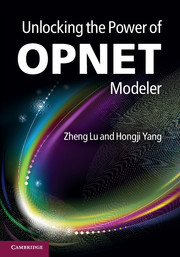Book contents
- Frontmatter
- Contents
- Preface
- List of abbreviations
- Part I Preparation for OPNET Modeling
- Part II Modeling Custom Networks and Protocols
- 4 OPNET programming interfaces
- 5 Creating and simulating custom models using OPNET APIs
- 6 High-level wrapper APIs
- 7 Modeling with high-level wrapper APIs
- Part III Modeling and Modifying Standard Networks and Protocols
- Part IV OPNET Modeling Facilities
- References
- Index
5 - Creating and simulating custom models using OPNET APIs
from Part II - Modeling Custom Networks and Protocols
Published online by Cambridge University Press: 05 February 2012
- Frontmatter
- Contents
- Preface
- List of abbreviations
- Part I Preparation for OPNET Modeling
- Part II Modeling Custom Networks and Protocols
- 4 OPNET programming interfaces
- 5 Creating and simulating custom models using OPNET APIs
- 6 High-level wrapper APIs
- 7 Modeling with high-level wrapper APIs
- Part III Modeling and Modifying Standard Networks and Protocols
- Part IV OPNET Modeling Facilities
- References
- Index
Summary
This chapter shows how to create and program custom models in OPNET Modeler with progressive case studies, to help readers gradually build up their knowledge on custom model creation. The chapter covers basic knowledge and techniques on custom model creation, model optimization, simulation, results visualization, comparison, and analysis. If readers already know the basics of simulation and how to create custom models, this chapter can be skipped.
General procedure for creating and simulating custom models
There are several ways to create simulation models and execute simulation. However, in this section, a general procedure of doing these via OPNET Modeler's GUI is introduced.
Q5.1 What are OPNET models?
OPNET models include node model, process model, link model, path model, network model, packet format models and ICI format model. Models are saved in .m files. For a node model, the file extension is “.nd.m.” For a link model, the file extension is “.lk.m.” For a process model, the file extension is “.pr.m.” These model files are saved in the model directory, which can be found from OPNET Modeler: choose menu “Edit” – “Preferences” – search for “Model Directories.”
First, custom models need to be created, and then a simulation scenario to test the custom models is created.
The following are the steps for creating custom models:
Design the custom node in Node Editor by separating different logic functionalities into different modules.
[…]
- Type
- Chapter
- Information
- Unlocking the Power of OPNET Modeler , pp. 58 - 99Publisher: Cambridge University PressPrint publication year: 2012



